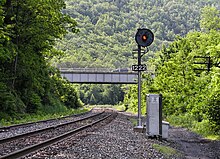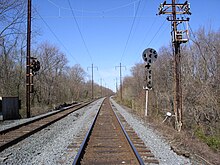| It has been suggested that this article be merged into Railway signal. (Discuss) Proposed since December 2024. |

Automatic block signaling (ABS), spelled automatic block signalling or called track circuit block (TCB) in the UK, is a railroad communications system that consists of a series of signals that divide a railway line into a series of sections, called blocks. The system controls the movement of trains between the blocks using automatic signals. ABS operation is designed to allow trains operating in the same direction to follow each other in a safe manner without risk of rear-end collision.
The introduction of ABS reduced railways' costs and increased their capacity. Older manual block systems required human operators. The automatic operation comes from the system's ability to detect whether blocks are occupied or otherwise obstructed, and to convey that information to approaching trains. The system operates without any outside intervention, unlike more modern traffic control systems that require external control to establish a flow of traffic.
History
The earliest way of managing multiple trains on one track was by use of a timetable and passing sidings. One train waited upon another, according to the instructions in the timetable, but if a train was delayed for any reason, all other trains might be delayed, waiting for it to appear at the proper place where they could pass safely. Operation of trains by timetable alone was supplemented by telegraphed train orders beginning in 1854 on the Erie Railroad. A railroad company dispatcher would send train orders to stations manned by telegraphers, who wrote them down on standardized forms and handed them to train crews as they passed the station.
A manual block system in the United States was implemented by the Pennsylvania Railroad about 1863, a couple of decades before other American railroads began using it. This system required a railroad employee stationed at each signal to set the signals according to instructions received by telegraph from dispatchers. English railroads also used a "controlled manual" block system, which was adapted for use in the U.S. by the New York Central and Hudson River Railroad in 1882.
The first use of automatic block signalling in the United Kingdom was installed on the Liverpool Overhead Railway on its opening in 1893. Instead of track circuits, the system used a setup of trackside mechanical, and later, electrical instruments (both functionally similar to treadles) that made contact with passing trains in order to trigger motor-operated mechanical signals. The first use of track circuit operated automatic block signalling in Britain was installed in 1902 by the LSWR's West of England line between Andover junction and Grateley which operated pneumatically powered mechanical signals.
By 1906, the Interstate Commerce Commission reported that of the 48,743 miles (78,444 km) of railroad in the United States that used a block system, there were 41,916 miles (67,457 km) protected by the manual block system, and only 6,827 miles (10,987 km) of automatic block, on either single or double track.
However, as time went on, many railroads came to see automatic block signaling as cost effective, since it reduced the need for employees to manually operate each signal, reduced the repair costs and damage claims resulting from collisions, made possible a more efficient flow of trains, reduced the number of hours trains and crews sat idle, and decreased overall transit times from point to point.
Basic operation
| This section needs additional citations for verification. Please help improve this article by adding citations to reliable sources in this section. Unsourced material may be challenged and removed. (October 2023) (Learn how and when to remove this message) |
Most ABS systems use three- or four-block arrangements, where an obstruction in the first block will prompt a warning upon entering the second block, and allow full speed for trains entering the third. Where blocks are short or higher capacity is needed, four or more blocks are used; trains are then given multiple warnings of an impending obstruction. For basic block status, the red/yellow/green system of signaling is nearly universal, with red indicating an obstructed block, yellow indicating that an obstructed block is ahead, and green indicating that no obstruction is to be expected.
In the United Kingdom
| This section relies excessively on references to primary sources. Please improve this section by adding secondary or tertiary sources. (February 2022) (Learn how and when to remove this message) |

In the UK, automatic signals are used where there are no ground frame, flat junctions, railroad switch facing and trailing, manually controlled level crossing, neutral sections, or other interlocking functions. It is standard practice to have an overlap after the signal. These overlaps can vary from 50 to 440 yards (46 to 402 m), with the standard overlap being 200 yards (180 m).
Single-direction ABS

The most common forms of ABS were implemented on double-track rail lines in high-density areas that exceeded the capacity provided by either timetable and train order or other manual forms of signaling. ABS would be set up in such a way to cover train movements only in a single direction for each track. The movement of trains running in that direction would be governed by the automatic block signals which would supersede the normal superiority of trains, where such systems applied. Movement of trains operating against the established flow of traffic would still require train orders or other special manual protections to prevent a collision. Therefore, under ABS operation trains moving in the wrong direction incurs additional operational overhead and may not be well supported by the track infrastructure.
See also
- Absolute block signalling
- Centralized traffic control
- Dark territory – Section of railway without signals
- Flagman – A person who controls the passage of a train by a level crossing
- Track circuit – Electrical device used to detect the presence of trains on rail tracks
- Track warrant
References
- ^ "SSP011 07-91 Controlled, Semi-Automatic and Automatic Colour Light Signals in TCB areas". RSSB.co.uk. Rail Safety and Standards Board. July 1, 1991. Retrieved February 21, 2022. (registration required)
- Gwyer, William L. (May 1, 2006). "Train Orders". Trains. Retrieved February 18, 2022.
- US 918539A, Samuel H. Harrington, "Automatic Block-Signal System", issued April 20, 1909, assigned to William C. Wilson
- ^ Report of the Interstate Commerce Commission on Block-Signal Systems and Appliances for the Automatic Control of Railroad Trains. Washington: Government Printing Office. 1907. Retrieved February 18, 2022.
- ^ Kitchenside, Geoffrey; Williams, Alan (2016). Two Centuries of Railway Signalling (2nd ed.). Addlestone, Surrey: Ian Allan.
- "Sign AC03 Iss 1: Automatic Signal Sign and Identification Plate". RSSB.co.uk. Rail Safety and Standards Board. June 6, 2015. Retrieved February 21, 2022. (registration required)
- "GKRT0064 Iss 1: Provision of Overlaps, Flank Protection and Trapping". RSSB.co.uk. Rail Safety and Standards Board. February 12, 2000. Retrieved February 18, 2022. (registration required)
- "SSP020 05-78: Overlaps". RSSB.co.uk. Rail Safety and Standards Board. October 31, 2016. Retrieved February 18, 2022. (registration required)
- Bryan, Frank W. (May 1, 2006). "Railroad's Traffic Control Systems". Trains. ABC's of Railroading. Kalmbach Media. Retrieved February 24, 2022.
- CT-400 Rules for Conducting Transportation (PDF). Pennsylvania Railroad. April 25, 1965. p. 51.
- Operating Rules. CSX Transportation. Rule 251 Section 2.
- "Centralized Traffic Control". Bulletin (176). Union Switch & Signal.
Further reading
- Solomon, Brian (2010). Railroad Signaling (2nd ed.). Voyageur Press. ISBN 978-0-7603-3881-0.